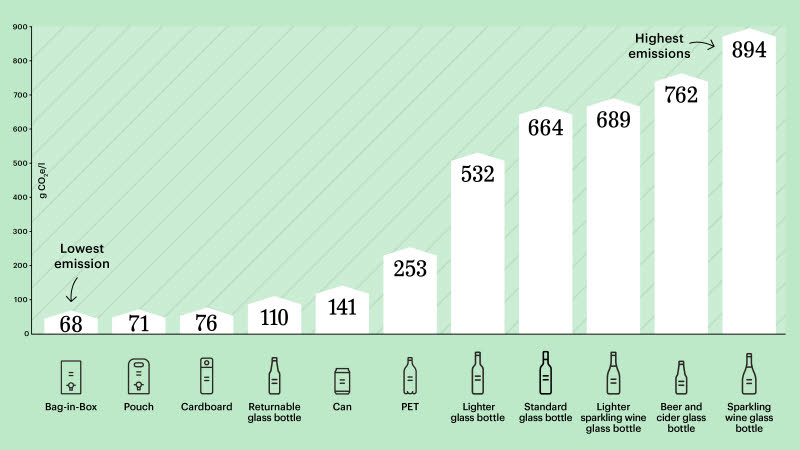By lower climate footprint we mean lower emissions of carbon dioxide and other greenhouse gases during the manufacturing the packaging than that generated by traditional “heavy” disposable glass bottles.
Approved packaging
The following beverage packaging is approved for use under the Our Most Sustainable Beverages guidnce:
- for wine, including sparkling wine, and spirits: Bag-In-Box, pouches, cardboard, deposit glass bottles, aluminium cans, PET plastic bottles and lighter glass bottles
2. for beer, cider and mixed beverages: aluminium cans, PET plastic bottles and deposit glass bottles.
Different climate footprint for different packaging
The following graph shows the climate footprint of various types of packaging (expressed as grams of CO2 emitted) during the manufacturing process. The figures state average emissions for each type of packaging.

The calculations are based on material consumption for the packaging size of each respective type of packaging with the largest sales in 2021:
- Bag-in-box 3 litre
- Pouch 2 litre
- Cardboard 1 litre
- Deposit glass bottle 0.5 litre
- Can 0.5 litre
- PET 0.7 litre
- Lighter glass bottle 0.75 litre
- Standard glass bottle 0.75 litre
- Lighter sparkling wine glass bottle 0.75 litre
- Beer and cider glass bottle: 0.33 litre
- Standard sparkling wine glass bottle: 0.75 litre
The weight of glass bottles varies widely. The weight used in the calculation for each respective bottle type and size is the weighted median of sales volume in 2021.
For comparison, all data are converted to carbon dioxide emissions per litre.
The calculations of carbon dioxide emissions from packaging were made in 2018 and 2019 on behalf of Alko (the Finnish alcoholic beverage retailing monopoly) in collaboration with Systembolaget and Vinmonopolet (the Norwegian wine monopoly). Climate footprint was calculated for the production and seal of the respective packaging.
You can find the final reports here:
Screening carbon footprint for aluminium wine packaging - Final report (pdf)
Update of winepackaging LCA – Final report Alko Oy (pdf)